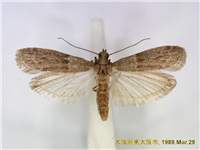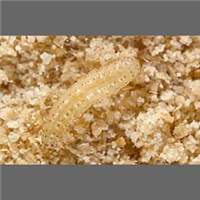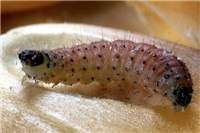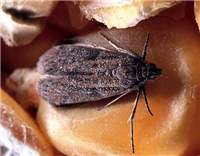Click on images to enlarge

Adult moth of the tropical warehouse moth, Cadra cautella. ©CSIRO Entomology, All rights reserved

Pinned specimen of the tropical warehouse moth, Cadra cautella. Image source unknown

Larva of the tropical warehouse moth, Cadra cautella. ©CSIRO Entomology, All rights reserved

Larva of the tropical warehouse moth, Cadra cautella. Photo: USDA, ARS (Public Domain)

Adult of the tropical warehouse moth, Cadra cautella. Photo: USDA, ARS (Public Domain)
Summary
The tropical warehouse moth is found throughout the tropics and subtropics where it is more common in non-arid areas. The tropical warehouse moth feeds on a range of stored foods, notably cereals and cereal products. The larvae (caterpillars) feed externally on maize grains but also cause damage to stored products through contamination with the silk webbing it produces and faecal pellets, cast skins and egg shells.
Common Names
Tropical warehouse moth, Mediterranean flour moth, Dried currant moth, Almond moth, Fig moth (English)
Synonyms
Cadra defectella Walker, 1864; Cryptoblabes formosella Wileman & South, 1918; Ephestia cautella (Walker, 1863); Ephestia irakella Amsel, 1959; Ephestia passulella Barrett, 1875; Ephestia pelopis Turner, 1947; Ephestia rotundatella Turati, 1930; Nephopteryx desuetella Walker, 1866; Nephopterix passulella (Barret, 1875); Pempelia cautella Walker, 1863
Taxonomic Position
Phylum: Arthropoda; Class: Hexapoda (Insecta); Order: Lepidoptera; Family: Pyralidae
Origin and Distribution
The tropical warehouse moth is found throughout the tropics and subtropics where it is more common in non-arid areas. It can be found in temperate countries but can only survive the winter in heated areas.
Description
Eggs The eggs are translucent yellow with a sculptured surface.
LarvaeThe larvae range from 1.5-15 mm in length and are light brown with dark brown spots with a sparse covering of hair.
Pupae Pupae are dark-brown and found within a relatively light pupal case.
AdultsThe adult forewings are greyish-brown with scattered darker patches. The wing span is 11-20 mm and both fore- and hind-wings have broadly rounded tips and short fringes of hairs.
Similar Species
The adult tropical warehouse moth is commonly confused with the Indian meal moth, Plodia interpunctella but can be differentiated from it by the distinct colouring of the forewings of Indian meal moth (a dark band separating the two differently coloured halves of the forewing). The larva resembles that of the Indian meal moth.
Life Cycle
The females lay their slightly sticky eggs on the stored food. Up to 300 eggs are laid in the first 3-4 days of their short (8-9 day) lives. At 30°C the eggs hatch in approximately 3 days. There are normally five larval instars and larval development, under optimum conditions (32.5°C and 70% relative humidity) is completed in about 22 days. In heavy infestations the mature larvae leave the produce to pupate on surfaces such as walls of the store or in spaces between bags. Before pupation, the last instar larva builds a cocoon. The pupal stage is completed in about 7 days. Adult emergence from the cocoon usually occurs during the late afternoon. Under optimum conditions, development from egg to adult takes 29-31 days.
Pest Destructive Stage
Larval stage (caterpillar )
Host Range
The tropical warehouse moth is a major pest of a range of stored foods, especially cereals (maize, rice, wheat, sorghum, millet, oats) flours and other cereal products, dried cassava, groundnuts, cocoa beans, dried mango, dates, nutmeg, mace, cowpeas and other dried stored products.
Host Lifestage Affected
Post-harvest and storage
Host Plant Part Affected
Fruits, pods seeds and grains
Damage Symptoms
External feeding and trails of silk webbing that contaminates stored products.
Pest Management
Detection methodsThe tropical warehouse moth can be detected by visual inspection. Sticky traps baited with a sex pheromone can be used to monitor adults.
Cultural practices
The severity of a tropical warehouse moth infestation can be reduced by good store hygiene which includes cleaning the store between harvests, immersing grain sacks in boiling water and fumigating the store to eliminate residual infestations, ensuring that all spillages are removed, all cracks and crevices in the store are filled and the selection of only uninfested material for storage. Infestations of this species may also be limited by the storage of good quality grains such as whole cereals with fewer broken grains.
Biological pest control
The mass release of the parasite Habrobracon hebetor has been used in South Africa to control the tropical warehouse moth in a sultana store as part of an integrated pest management programme.
Controlled atmosphereWhere suitable infrastructure exists, low oxygen and carbon dioxide-enriched atmospheres can be used to control stored product pests.
Freezing and HeatingWhere the infrastructure exists, freezing for several days and heating for 24 hours have proved to be effective control methods for stored product pests.
Chemical control
Fumigation of grain stocks with phosphine will control existing infestations but will not protect against re-infestation. An admixture of approved grain insecticides, especially organophosphorus compounds, will protect against this pest. Store misting or fogging at times of peak flight activity may be used to control the adult population. Pesticides are poisons so it is essential to follow all safety precautions on labels.
Sources of Information and Links
Burges HD, Haskins KPF, 1965. Life-cycle of the tropical warehouse moth, Cadra cautella (Wlk.) at controlled temperatures and humidities. Bulletin of Entomological Research, 55(4):775-789.
CABI. (2007) Ephestia cautella (Walker) Tropical warehouse moth datasheet. Crop Protection Compendium, 2007 Edition. CAB International Publishing. Wallingford, UK.
Dent D. (2000). Insect pest management.CAB International Wallingford, UK
Infonet-Biovision. http://www.infonet-biovision.org/default/ct/91/pests. Accessed on 28 Jan 2011.
Gaby, S. (1988) Natural crop protection in the tropics. Margraf Publishers Scientific books, German
Krischik, V.A., Cuperus G. and Galliart D. (eds.).(1995). Stored Products Management, 2nd Ed. Oklahoma State Univ. 204 pp. http://www.grainscanada.gc.ca/storage-entrepose/pip-irp/lgb-ppg-eng.htm#d accessed on 15/5/2010.
Ridgway, R.L. Silverstein R.M and Inscoe, M.N. (1990) Behaviour- modifying chemicals for insect management, Marcel Dekker Inc., New York.
Youdeowei A. (1993) Pest and vector management in the tropics, Longman Group Ltd England.
Editors
Anne M. Akol, Makerere University; Maneno Y. Chidege, Tropical Pesticides Research Institute; Herbert A.L. Talwana, Makerere University; John R. Mauremootoo, BioNET-INTERNATIONAL Secretariat.
Acknowledgments
We recognise the support from the National Museums of Kenya, Tropical Pesticides Research Institute (TPRI) - Tanzania and Makerere University, Uganda. This activity was undertaken as part of the BioNET-EAFRINET UVIMA Project (Taxonomy for Development in East Africa).
Contact
BioNET-EAFRINET Regional Coordinator: [email protected]












